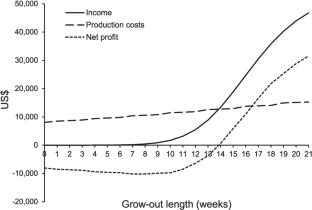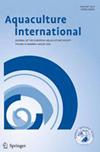Alfredo Hernández-Llamas, Magda E. Domínguez-Machín, Álvaro Hernández-Flores, Miguel A. Vela-Magaña
求助PDF
{"title":"Stochastic bioeconomic approach for optimum design of aquaculture investment projects: case of stocking density, rotation time, and production scale for eastern oyster Crassostrea virginica farming in Yucatan, Mexico","authors":"Alfredo Hernández-Llamas, Magda E. Domínguez-Machín, Álvaro Hernández-Flores, Miguel A. Vela-Magaña","doi":"10.1007/s10499-025-02231-1","DOIUrl":null,"url":null,"abstract":"<div><p>A stochastic bioeconomic approach is introduced to optimize the design of aquaculture investment projects. Eastern oyster (<i>Crassostrea virginica</i>) farming in Yucatan, Mexico, serves as a case study using stocking density, rotation time, and production scale as decision variables for design optimization. The results from the Monte Carlo simulation and an optimization algorithm revealed that the maximum mean internal rate of return (IRR) and net present value (NPV) were 29.8% and US$69,947.63, respectively, and the optimum design was obtained by covering 78% of the area of rearing gear (NESTIER©-type trays), 21-week rotation time (2.5 crops/year), and planting 426,000 juveniles. A pilot project was projected for a production scale of 338,000 planted juveniles, where a minimum attraction rate of return (13.15%) is expected. The mean net profit over production costs was US$31,543.47 under the optimum scenario, requiring the production of 23,300 dozen oysters. Considering the optimal rotation time, the total annual net profit and production are US$78,858.6 and 58,250 dozen, respectively. The sensitivity analyses revealed that oyster prices and the recruitment process to oyster commercial populations primarily affected net profit, whereas stocking density and production scale had similar effects on the IRR. Optimizing the design of an aquaculture project is a complex problem involving careful balancing of multiple biological, operational, and economic aspects. This study demonstrates that a stochastic bioeconomic approach and optimization algorithms are effective tools for comprehensively addressing such complexity. </p></div>","PeriodicalId":8122,"journal":{"name":"Aquaculture International","volume":"33 6","pages":""},"PeriodicalIF":2.4000,"publicationDate":"2025-09-27","publicationTypes":"Journal Article","fieldsOfStudy":null,"isOpenAccess":false,"openAccessPdf":"","citationCount":"0","resultStr":null,"platform":"Semanticscholar","paperid":null,"PeriodicalName":"Aquaculture International","FirstCategoryId":"97","ListUrlMain":"https://link.springer.com/article/10.1007/s10499-025-02231-1","RegionNum":3,"RegionCategory":"农林科学","ArticlePicture":[],"TitleCN":null,"AbstractTextCN":null,"PMCID":null,"EPubDate":"","PubModel":"","JCR":"Q2","JCRName":"FISHERIES","Score":null,"Total":0}
引用次数: 0
引用
批量引用
Abstract
A stochastic bioeconomic approach is introduced to optimize the design of aquaculture investment projects. Eastern oyster (Crassostrea virginica ) farming in Yucatan, Mexico, serves as a case study using stocking density, rotation time, and production scale as decision variables for design optimization. The results from the Monte Carlo simulation and an optimization algorithm revealed that the maximum mean internal rate of return (IRR) and net present value (NPV) were 29.8% and US$69,947.63, respectively, and the optimum design was obtained by covering 78% of the area of rearing gear (NESTIER©-type trays), 21-week rotation time (2.5 crops/year), and planting 426,000 juveniles. A pilot project was projected for a production scale of 338,000 planted juveniles, where a minimum attraction rate of return (13.15%) is expected. The mean net profit over production costs was US$31,543.47 under the optimum scenario, requiring the production of 23,300 dozen oysters. Considering the optimal rotation time, the total annual net profit and production are US$78,858.6 and 58,250 dozen, respectively. The sensitivity analyses revealed that oyster prices and the recruitment process to oyster commercial populations primarily affected net profit, whereas stocking density and production scale had similar effects on the IRR. Optimizing the design of an aquaculture project is a complex problem involving careful balancing of multiple biological, operational, and economic aspects. This study demonstrates that a stochastic bioeconomic approach and optimization algorithms are effective tools for comprehensively addressing such complexity.
水产养殖投资项目优化设计的随机生物经济方法——以墨西哥尤卡坦东部牡蛎养殖密度、轮作时间和生产规模为例
引入随机生物经济学方法对水产养殖投资项目进行优化设计。以墨西哥尤卡坦半岛的东部牡蛎(Crassostrea virginica)养殖为例,利用放养密度、轮作时间和生产规模作为设计优化的决策变量。蒙特卡罗模拟和优化算法结果表明,在饲养装置(NESTIER©型托盘)占地78%、轮作时间21周(2.5茬/年)、种植42.6万只幼鱼的条件下,平均内部收益率(IRR)和净现值(NPV)最大分别为29.8%和69,947.63美元。试点规模为种植幼鱼33.8万株,预计最低吸引收益率为13.15%。在最佳情况下,平均净利润除以生产成本为31,543.47美元,需要生产23,300打牡蛎。考虑最优轮换时间,全年净利润和产量分别为78,858.6美元和58,250打。敏感性分析表明,牡蛎价格和对牡蛎商业种群的招募过程主要影响净利润,而放养密度和生产规模对IRR的影响相似。水产养殖项目的优化设计是一个复杂的问题,涉及多个生物、操作和经济方面的仔细平衡。该研究表明,随机生物经济方法和优化算法是全面解决这种复杂性的有效工具。
本文章由计算机程序翻译,如有差异,请以英文原文为准。


 求助内容:
求助内容: 应助结果提醒方式:
应助结果提醒方式:


